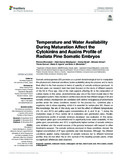Mostrar el registro sencillo del ítem
Temperature and water availability during maturation affect the cytokinins and auxins profile of radiata pine somatic embryos
| dc.creator | Moncaleán, Paloma | es_ES |
| dc.creator | García Mendiguren, Olatz | es_ES |
| dc.creator | Novák, Ondrej | es_ES |
| dc.creator | Strnad,Miroslav | es_ES |
| dc.creator | Goicoa Mangado, Tomás | es_ES |
| dc.creator | Ugarte Martínez, María Dolores | es_ES |
| dc.creator | Montalbán, Itziar A. | es_ES |
| dc.date.accessioned | 2019-07-17T12:13:05Z | |
| dc.date.available | 2019-07-17T12:13:05Z | |
| dc.date.issued | 2018 | |
| dc.identifier.issn | 1664-462X | |
| dc.identifier.uri | https://hdl.handle.net/2454/33578 | |
| dc.description.abstract | Somatic embryogenesis (SE) provides us a potent biotechnological tool to manipulate the physical and chemical conditions (water availability) along the process and to study their effect in the final success in terms of quantity of somatic embryos produced. In the last years, our research team has been focused on the study of different aspects of the SE in Pinus spp. One of the main aspects affecting SE is the composition of culture media; in this sense, phytohormones play one of the most crucial roles in this propagation system. Many studies in conifers have shown that different stages of SE and somatic embryo development are correlated with distinct endogenous phytohormone profiles under the stress conditions needed for the process (i.e., cytokinins play a regulatory role in stress signaling, which it is essential for radiata pine SE). Based on this knowledge, the aim of this study was to test the effect of different temperatures (18, 23, and 28°C) and gelling agent concentrations (8, 9, and 10 gL-1) during the maturation stage of Pinus radiata SE in maturation and germination rates. Parallel, phytohormone profile of somatic embryos developed was evaluated. In this sense, the highest gellan gum concentration led to significantly lower water availability. At this gellan gum concentration and 23°C a significantly higher number of somatic embryos was obtained and the overall success of the process increased with respect to other treatments assayed. The somatic embryos produced in these conditions showed the highest concentration of iP-type cytokinins and total ribosides. Although, the different conditions applied during maturation of somatic embryos led to different hormonal profiles, they did not affect the ex vitro survival of the resulting somatic plants, where no significant differences were observed. | en |
| dc.description.sponsorship | This research was funded by MINECO (Spanish Government) project (AGL2016-76143-C4-3R), CYTED (P117RT0522), and DECO (Basque Government). The Ministry of Education, Youth and Sports of the Czechia provided support for this project via the National Program for Sustainability I (LO1204). | en |
| dc.format.extent | 13 p. | |
| dc.format.mimetype | application/pdf | en |
| dc.format.mimetype | application/zip | en |
| dc.language.iso | eng | en |
| dc.publisher | Frontiers Media | en |
| dc.relation.ispartof | Frontiers in Plant Science, 9:1898 | en |
| dc.rights | © 2018 Moncaleán, García-Mendiguren, Novák, Strnad, Goicoa, Ugarte and Montalbán. This is an open-access article distributed under the terms of the Creative Commons Attribution License (CC BY). The use, distribution or reproduction in other forums is permitted, provided the original author(s) and the copyright owner(s) are credited and that the original publication in this journal is cited, in accordance with accepted academic practice. No use, distribution or reproduction is permitted which does not comply with these terms. | en |
| dc.rights.uri | http://creativecommons.org/licenses/by/4.0/ | |
| dc.subject | Cytokinins | en |
| dc.subject | Embryogenic cell lines | en |
| dc.subject | Embryonal masses | en |
| dc.subject | Indol-3-acetic acid | en |
| dc.subject | Pinus radiata | en |
| dc.subject | Somatic embryogenesis | en |
| dc.title | Temperature and water availability during maturation affect the cytokinins and auxins profile of radiata pine somatic embryos | en |
| dc.type | info:eu-repo/semantics/article | en |
| dc.type | Artículo / Artikulua | es |
| dc.contributor.department | Estadística, Informática y Matemáticas | es_ES |
| dc.contributor.department | Estatistika, Informatika eta Matematika | eu |
| dc.rights.accessRights | info:eu-repo/semantics/openAccess | en |
| dc.rights.accessRights | Acceso abierto / Sarbide irekia | es |
| dc.identifier.doi | 10.3389/fpls.2018.01898 | |
| dc.relation.projectID | info:eu-repo/grantAgreement/MINECO/Plan Estatal de Investigación Científica y Técnica y de Innovación 2013-2016/AGL2016-76143-C4-3R | en |
| dc.relation.publisherversion | https://doi.org/10.3389/fpls.2018.01898 | |
| dc.type.version | info:eu-repo/semantics/publishedVersion | en |
| dc.type.version | Versión publicada / Argitaratu den bertsioa | es |
Ficheros en el ítem
Este ítem aparece en la(s) siguiente(s) colección(ones)
La licencia del ítem se describe como © 2018 Moncaleán, García-Mendiguren, Novák, Strnad, Goicoa, Ugarte and Montalbán. This is an open-access article distributed under the terms of the Creative Commons Attribution License (CC BY). The use, distribution or reproduction in other forums is permitted, provided the original author(s) and the copyright owner(s) are credited and that the original publication in this journal is cited, in accordance with accepted academic practice. No use, distribution or reproduction is permitted which does not comply with these terms.




